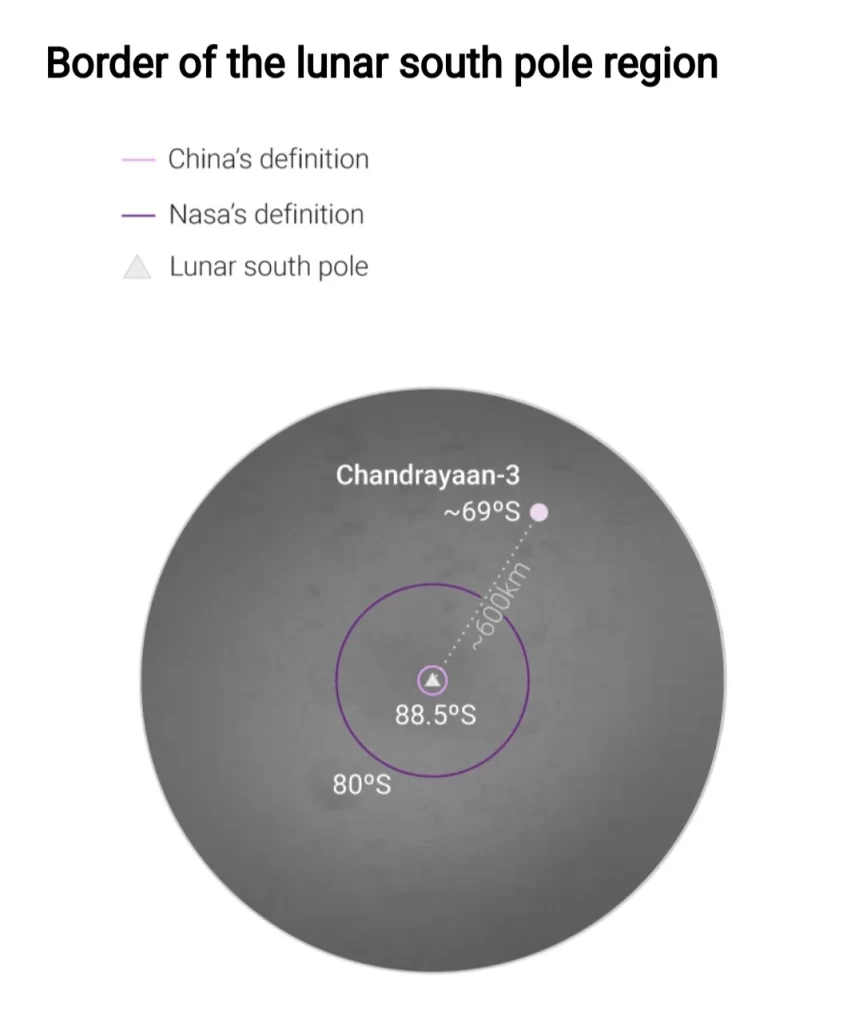The “founding father” of China’s lunar exploration program has disagreed with India’s statement that its spacecraft landed close to the moon’s south pole in a historic mission in August.
Prime Minister Narendra Modi, following the Chandrayaan-3 landing, expressed that due to the dedication and expertise of our scientists, India has successfully reached the moon’s south pole, a destination unexplored by any other nation worldwide.
On Wednesday, Chinese cosmochemist Ouyang Ziyuan, the chief scientist on China’s first lunar mission, contested the claim that the spacecraft had touched down near the moon’s south pole, stating that it was inaccurate.
Ouyang, a member of the Chinese Academy of Sciences, informed the official Science Times newspaper that the Chandrayaan-3’s landing site was not situated at the moon’s south pole, nor was it within the polar area of the moon’s south pole, and it was not close to the Antarctic polar region either.
Ouyang explained to the news site that the rover landed at a latitude of approximately 69 degrees south, placing it within the moon’s southern hemisphere but not in what he defined as the polar region, which he specified as being “between the latitudes of 88.5 and 90 degrees.”

While Earth’s rotational axis is tilted about 23.5 degrees concerning the sun, defining the southern pole between 66.5 and 90 degrees south, Ouyang contended that the moon’s much smaller tilt, only 1.5 degrees, resulted in a significantly smaller polar region.
As per the European Space Agency, although the Chandrayaan-3 landing site wasn’t precisely at the south pole, attempting a landing directly at the south pole proved exceptionally challenging due to its positioning on the edge of the Shackleton crater.
The Shackleton crater has a depth of approximately 4.2 kilometres (about 2.6 miles). The opening or width of the Shackleton crater is approximately 21 kilometres (about 13 miles) across.
This substantial depth creates permanently shadowed regions within the crater, making it a compelling area for potential water ice deposits on the moon.
In the United States, NASA defines the “entire” polar region from 80 to 90 degrees south on the moon. Following this definition, Chandrayaan-3’s landing occurred beyond the polar region but at a higher latitude than previous moon missions have reached.
NASA chief Bill Nelson shared a message on X, previously called Twitter, to congratulate the Indian Space Research Organisation for their successful “landing near the lunar south pole” on August 23.
Richard de Grijs, a professor at Sydney’s Macquarie University School of Mathematical and Physical Sciences, also asserted that the Indian mission had landed in a zone regarded as outside the lunar south pole region.
Although the probe’s landing site is often labelled as the ‘polar region’ in news media and various publications, it’s important to note that Chandrayaan-3’s location falls outside the lunar Antarctic Circle, which is defined as the lunar geographical area south of 80 degrees south.”
De Grijs referred to a scientific paper from researchers from the Physical Research Laboratory, a division of the Indian government’s space department. This paper was published in the peer-reviewed journal Monthly Notices of the Royal Astronomical Society in early August.
Within the paper, the research team outlined their efforts in selecting a landing site, characterizing it as “a high-latitude position on the moon.”
A separate study from scientists from the same department, published on September 15 in the solar system journal Icarus, indicated that the landing site was situated in “the southern high-latitude region.”
De Grijs pointed out that numerous media outlets may have joined the trend in characterizing the landing site as being near the lunar south pole. He noted that a few years ago, there was preliminary evidence of frozen water ice near the moon’s south pole, much closer to the south pole than where Chandrayaan-3 landed.
He emphasized the necessity for further research to assess the viability of utilizing the water ice for a potential lunar base in the future.
Planetary dynamicist Lee Man-hoi, affiliated with the University of Hong Kong, mentioned that Chandrayaan-3 had achieved the most southern latitude of any moon lander. He also pointed to the Indian team’s characterization of the site as a “high-latitude location.”
In contrast, Lee remarked that China’s Chang’e 4 successfully landed on the far side of the moon within an area known as the South Pole-Aitken Basin in 2019.
Based on the name, you might assume that Chang’e 4 touched down nearer to the south pole, but that’s not accurate,” he clarified, indicating that it landed at a latitude of 45.44 degrees south.
Astrophysicist Quentin Parker, the director of HKU’s Laboratory for Space Research, noted that the debate was becoming a matter of semantics, even though the spacecraft had not precisely landed at the moon’s south pole.
Semantics, on the other hand, refers to the study of how statements are understood and interpreted, especially when doing so requires paying attention to nuanced or subtle differences in language.
Achieving a rover landing near the south pole, and unquestionably within the designated south pole region, is already a significant accomplishment,” he affirmed. “I believe India should be fully credited for this achievement, without any doubt.”
He expressed that it presents an opportunity to “commemorate the accomplishments of science and humanity.”
Anyone with the technical capability can approach closer if they choose to. India has achieved a closer approach than anyone else, but it would be a remarkable and commendable feat if China manages to get even closer next time.
China is preparing for its lunar mission set for 2026, with plans to land the Chang’e 7 rover near the Shackleton crater at the moon’s south pole.
Images from a presentation in April by China’s Deep Space Exploration Laboratory show a targeted landing site at 88.8 degrees south – within the boundaries of the polar region defined by Ouyang.
